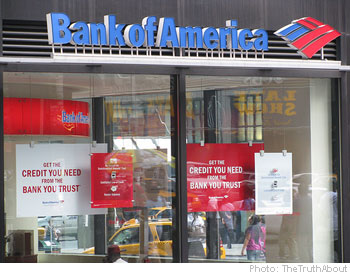 Everybody knows by now that Bank of America (BAC) is buying back the $45 billion of preferred stock that the government currently owns. While the reason why they are doing this is obvious, I’m going to pretend it isn’t for a few paragraphs.
Everybody knows by now that Bank of America (BAC) is buying back the $45 billion of preferred stock that the government currently owns. While the reason why they are doing this is obvious, I’m going to pretend it isn’t for a few paragraphs.
Buying back stock costs money — real cash money. Why would a company ever do such a thing? The textbook answer is that a company should do it if it doesn’t have investment opportunities that yield more than its cost of capital. The cash in its bank account, in some sense, belongs to its shareholders, who expect a certain return. If the bank can’t earn that return with the cash, it should return it to the shareholders. In this case, though, the interest rate on the preferred shares is only 5%, which is far lower than usual cost of equity. In fact, Bank of America just issued $19 billion of new stock in order to help buy back the government’s preferred stock. The cost of that new equity (in corporate finance terms) is certainly higher than 5%. In other words, Bank of America just threw money away.
In practice, companies buy back stock in order to increase their earnings per share. Fewer shares outstanding and the same earnings mean higher earnings per share and a higher stock price. In theory, this shouldn’t work: the benefit of having fewer shares should be exactly balanced by the fact that the company is now worth less (because it has, say, $45 billion less cash than it had yesterday). But in practice, it seems to work, probably because of signaling. But that doesn’t make sense in this case, either, since these are preferred shares that Bank of America is buying back, which have no claim on earnings. In effect, Bank of America is paying off cheap (5%) debt it doesn’t have to pay off — and to do that, it’s issuing new common shares, which will dilute existing shareholders.
Paying back its TARP money also has the effect of making Bank of America weaker. From a liquidity perspective, it now has about $20-25 billion ($45 billion minus $19 billion raised from new equity minus a few billion from other asset sales) less cash than it did before paying the money back. From a capital perspective, using cash to buy back preferred shares reduces your Tier 1 capital ratio. (I know there is disagreement about this, but the term sheet explicitly said that Treasury’s preferred shares counted as Tier 1 capital.)
So why?
The answer … which most of you know already … is to avoid executive compensation caps. From the Times article:
“It is a particularly delicate time for Bank of America, which has struggled to find a replacement for Mr. Lewis. By paying back the money that it received under the Troubled Asset Relief Program, or TARP, Bank of America will free itself from exceptional federal oversight of its executives’ pay — a thorny issue in recruiting a new chief executive.”
In retrospect, the executive compensation caps inserted by Congress into the stimulus bill back in February are having a perverse effect. Because the caps applied only to financial institutions that took TARP money — and they applied much more heavily to institutions that received “exceptional assistance,” like Citigroup and Bank of America — it tilted the paying field even more heavily against them. This gives them an incentive to take steps that weaken their financial condition, even as conditions in the real economy (to which Bank of America is highly exposed) remain bleak.
I support restrictions on the form of compensation in financial institutions, such as requiring them to be distributed in restricted stock that vests over several years (which is already standard practice at some banks, such as Goldman Sachs) and making bonuses in good years subject to clawbacks in bad years. But those restrictions have to apply to all financial institutions, not just some of them; otherwise, you get this situation where Bank of America is making a silly financial decision because it has to in order to hire a new CEO. (The fact that nobody will be CEO of America’s largest bank because of executive comp restrictions is another issue, but there’s not much we can do about that. I would do it, but I don’t want to move to Charlotte.)
Update: Ted K. pointed out to me that Wells Fargo, which is generally considered less of a basket case than Bank of America, is not paying back its TARP money yet.


How much of this is Wells Fargo being a more responsibly run institution versus their ability to piggy-back off of the myriad government bailouts outside of TARP? For example, with or without TARP money, they still benefit from low rates, quantitative easing, and the post-Lehman all but explicit government guarantee of financial institution debt. Why keep TARP money when you can pay yourself large bonuses and let the government bail you out if things don’t work out, as was demonstrated repeatedly by C and BAC after Lehman collapsed?
Stephanie Mcnealy.